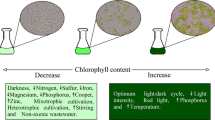Abstract
Cultures of the unicellular green alga Chlamydomonas reinhardii can be synchronized by light/dark cycling not only under photoautotrophic but also under mixotrophic growth conditions. We observed that cultures synchronized in the presence of acetate continue to divide synchronously for one cell-cycle period when transferred to heterotrophic growth conditions. This finding enabled us to investigate the differential effects of light on cell growth and cell division. When cells were exposed to continuous light at the beginning of the growth period they entered the division phase earlier than dark-grown cells as a consequence of an increased growth rate. Illumination at the end of the growth period, however, caused a considerable delay in cell division and an extended growth period. The light-induced delay in cell division was also observed in the presence of 3-(3′,4′-dichlorophenyl)-1,1-dimethylurea (DCMU), an inhibitor of photosystem II. This finding demonstrates that cell division is directly influenced by a light/dard-responsive cell-cycle switch rather than by light/dark-dependent changes in energy metabolism. The importance of this light/dark control to the regulation of the Chlamydomonas cell cycle was investigated in comparison with other control mechanisms (size control, time control). We found that the light/dard-responsive cell-cycle switch regulates the transition from G1-to S-phase. This control mechanism is effective in cells which have attained the commitment to at least one round of DNA replication and division but have not attained the maximal cell mass which initiates cell division in the light.
Similar content being viewed by others
Abbreviations
- dCTP:
-
deoxycytidine 5′-triphosphate
- DCMU:
-
3-(3′,4′-dichlorophenyl)-1,1-dimethylurea
References
Bernstein, E. (1964) Physiology of an obligate photoautotroph (Chlamydomonas moewusii). I. Characteristics of synchronously and randomly reproducing cells and an hypothesis to explain their population curves. J Protozool. 11, 56–74
Bruce, V. (1970) The biological clock in Chlamydomonas reinhardii. J. Protozool. 17, 334–340
Chiang, K.S., Sueoka, N. (1976) Replication of chloroplast DNA in Chlamydomonas reinhardii during vegetative cell cycle: its mode and regulation. Proc. Natl. Acad. Sci. USA 57, 1506–1513
Craigie, R.A., Cavalier-Smith, T. (1982) Cell volume and the control of the Chlamydomonas cell cycle. J. Cell Sci. 54, 173–191
Davies, D.R., Plaskitt, A. (1971) Genetical and structural analysis of cell-wall formation in Chlamydomonas reinhardii. Genet. Res. 17, 33–43
Donnan, L., John, P.C.L. (1983) Cell cycle control by timer and sizer in Chlamydomonas. Nature 304, 630–633
Grant, D., Swinton, D.C., Chiang, K.S. (1978) Differential patterns of mitochondrial, chloroplastic and nuclear DNA synthesis in the synchronous cell cycle of Chlamydomonas reinhardii. Plant 141, 259–267
Hopkins, H.A., Flora, J.B., Schmidt, R.R. (1972) Periodic DNA accumulation during the cell cycle of a thermophilic strain of Chlorella pyrenoidosa. Arch. Biochem. Biophys. 153, 845–849
Hutner, S.H., Provasoli, L., Schatz, A., Haskins, C.P. (1950) Some approaches to the role of metals in the metabolism of microorganisms. Proc. Am. Philos. Soc. 94, 152–170
Jarret, R.M., Edmunds, L.N. (1970) Persisting circadian rhythm of cell division in a photosynthetic mutant of Euglena. Science (Wash. D.C.) 167, 1730–1733
John, P.C.L. (1984) Control of the cell division in Chlamydomonas. Microbiol. Sci. 1, 96–101
Kates, J.R., Jones, R.F. (1964) The control of gametic differentiation in liquid cultures of Chlamydomonas. J. Cell. Comp. Physiol. 63, 157–164
Keller, L.R., Schloss, J.A., Silflow, C.D., Rosenbaum, J.L. (1984) Transcription of α- and β-tubulin genes in vitro in isolated Chlamydomonas reinhardii nuclei. J. Cell Biol. 98, 1138–1143
Lorenzen, H. (1957) Synchrone Zellteilungen von Chlorella bei verschiedenen Licht-Dunkel-Wechseln. Flora 144, 473–496
Lorenzen, H., Hesse, M. (1974) Synchronous cultures. In: Algal physiology and biochemistry, pp. 894–908, Steward, W.D.P., ed., Blackwell, Oxford
Lowry, O.H., Rosebrough, N.J., Farr, A.L., Randle, R.J. (1951) Protein measurement with the folin phenol reagent. J. Biol. Chem. 193, 257–265
Mergenhagen, D. (1980) Die Kinetik der Zoosporenfreisetzung bei einem Mutantenstamm von Chlamydomonas reihardii. Mitt. Inst. Allg. Bot. Hamburg 17, 18–26
Mihara, S., Hase, E. (1971) Studies on the vegetative life cycle of Chlamydomonas reinhardii Dangeard in synchronous culture. I. Some characteristics of the cell cycle. Plant Cell Physiol. 12, 225–236
Pirson, A., Lorenzen, H. (1966) Synchronized dividing algae. Annu. Rev. Plant Physiol. 17, 439–458
Ross, C.A., Harris, W.J. (1978) DNA polymerases from Chlamydomonas reinhardii. Purification and properties. Biochem. J. 171, 231–240
Sala, F., Parisi, B., Burroni, D., Amileni, A.R., Pedrali-Noy, G., Spadari, S. (1980) Specific and reversible inhibition by aphidicolin of the α-like DNA polymerase of plant cells. FEBS Lett 117, 93–98
Schlösser, U.G. (1966) Enzymatisch gesteuerte Freisetzung von Zoosporen bei Chlamydomonas reinhardii Dangeard in Synchronkultur. Arch. Mikrobiol. 54, 129–159
Spudich, J.L., Sager, R. (1980) Regulation of the Chlamydomonas cell cycle by light and dark. J. Cell Biol. 85, 136–145
Straley, S.C., Bruce, V.G. (1979) Stickiness to glass. Circadian changes in the cell surface of Chlamydomonas reinhardii. Plant Physiol. 63, 1175–1181
Sueoka, N., Chiang, K.S., Kates, J.R. (1967) Deoxyribonucleic acid replication in meiosis of Chlamydomonas reinhardii. J. Mol. Biol. 25, 45–66
Wetherell, D.F. (1958) Obligate autotrophy in Chlamydomonas eugametos. Physiol. Plant. 11, 260–274
Wintermans, J.F.G.M., De Mots, A. (1965) Spectrophotometric characteristics of chlorophylls a and b and their pheophytins in ethanol. Biochim. Biophys. Acta 109, 448–453
Author information
Authors and Affiliations
Rights and permissions
About this article
Cite this article
Voigt, J., Münzner, P. The Chlamydomonas cell cycle is regulated by a light/dark-responsive cell-cycle switch. Planta 172, 463–472 (1987). https://doi.org/10.1007/BF00393861
Received:
Accepted:
Issue Date:
DOI: https://doi.org/10.1007/BF00393861




